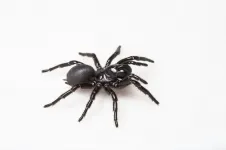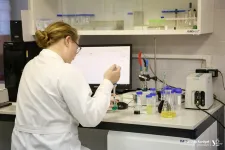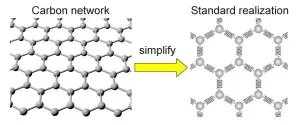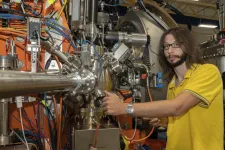CHOP researchers establish novel approach for developing new antibiotics
New study proposes structure-guided design to create prodrugs that act as a "Trojan Horse," allowing antibiotics to reach resistant bacteria
2021-07-19
(Press-News.org) Philadelphia, July 19, 2021--Researchers at Children's Hospital of Philadelphia (CHOP) have developed a novel method for producing new antibiotics to combat resistant bacteria. Through an approach that would target bacteria with an antibiotic that is masked by a prodrug, which the bacteria would themselves remove, the researchers identified a method that would allow for development of new, effective antibiotics that could overcome issues of resistance. The findings were published today in eLife.
"We've created a sort of 'Trojan Horse' that would allow antibiotics to reach desired tissues undisturbed, until the bacteria itself activates the drug, effectively releasing an 'army' of antibiotics," said senior author Audrey R. Odom John, MD, PhD, Chief of the Division of Pediatric Infectious Diseases at CHOP. "Using structure-guided design, we have developed a new way to design better antibiotics. Given the growing concern over antimicrobial resistance, we think this is an important step forward."
Antimicrobial resistance poses a serious threat to public health, with some estimates suggesting that antimicrobial-resistant infections will cause as many as 10 million deaths per year by 2050. To combat this public health threat, scientists will need to develop new, chemically distinct antibiotics that can circumvent antimicrobial resistance, but most attempts to do so have either failed in animal or human models or have been unable to get sufficient levels of treatment to the desired tissues.
To tackle this problem, the researchers took a new approach that relied on exploiting bacterial metabolism, processes that are essential for bacteria to thrive. Drugs that inhibit these processes could eradicate the bacteria, but the chemical group that would inhibit those enzymes has a negative charge, which prevents the drugs from entering cells, creating a challenge.
One way to overcome that challenge is to chemically mask the undesirable negative charge with another chemical group. This strategy, known as prodrugging, adds a sort of shield - the "Trojan Horse" - that masks the negative charge, allows the drug to enter the cell, and then is removed during absorption to allow the original antibiotic to be taken up. However, the prodrug must also be resistant to host enzymes; otherwise, the prodrug mask will be removed too early, and the drug will never reach the desired tissue.
Focusing on Staphylococcus aureus, since methicillin-resistant S. aureus (MRSA) has been labeled a "serious threat" by the Centers for Disease Control and Prevention, the researchers looked for bacterial enzymes that interacted with specific targets that would not interact with host enzymes. Doing so, they were able to characterize two enzymes - GloB and FrmB - that each have defined substrate specificities - that is, highly specific molecules with which they will interact - and, importantly, those specificities are different than those of human enzymes. Thus, these enzymes could remove prodrug additions, activating the antibiotic, without the prodrugs first being degraded by the host.
Having determined GloB and FrmB were suitable bacterial enzyme targets, the researchers characterized the three-dimensional structures of GloB and FrmB, which confirmed their active sites and will enable ongoing structure-guided design of FrmB- and GloB-targeted prodrugs.
"This work paves the way for structure-guided development of S. aureus-specific prodrugs and establishes a pipeline for the identification of additional microbial prodrug activating enzymes," John said. "We anticipate that these approaches will both guide the development of novel antimicrobials and lead to a more robust arsenal of anti-infective compounds with targeted specificity for the microbe over the human host."
INFORMATION:
Miller et al. "Structure-guided microbial targeting of antistaphylococcal prodrugs," eLife, online July 19, 2021, DOI: 10.7554/eLife.66657
About Children's Hospital of Philadelphia: Children's Hospital of Philadelphia was founded in 1855 as the nation's first pediatric hospital. Through its long-standing commitment to providing exceptional patient care, training new generations of pediatric healthcare professionals, and pioneering major research initiatives, Children's Hospital has fostered many discoveries that have benefited children worldwide. Its pediatric research program is among the largest in the country. In addition, its unique family-centered care and public service programs have brought the 595-bed hospital recognition as a leading advocate for children and adolescents. For more information, visit http://www.chop.edu
[Attachments] See images for this press release:
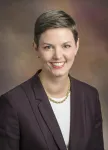
ELSE PRESS RELEASES FROM THIS DATE:
2021-07-19
(Edmonton, AB) Firefighters at the centre of the battle against the massive Fort McMurray wildfire in 2016 have persistent lung damage, according to new findings published by a University of Alberta occupational health research team.
"Those who were dealing with burning organic matter were exposed to a barrage of small particles in the smoke, and the ones with the highest exposure have long-term consequences," said principal investigator Nicola Cherry, an occupational epidemiologist, professor of medicine and Tripartite Chair of Occupational Health in the Faculty of Medicine & Dentistry.
The firefighters had more ...
2021-07-19
BIRMINGHAM, Ala. - An experimental drug reported in Nature Communications suggests that a "path is clearly achievable" to treat currently untreatable cases of cystic fibrosis disease caused by nonsense mutations. This includes about 11 percent of cystic fibrosis patients, as well as patients with other genetic diseases, including Duchenne muscular dystrophy, β-thalassemia and numerous types of cancers, that are also caused by nonsense mutations.
The drug is a small molecule with a novel mechanism of action, say David Bedwell, Ph.D., and Steven Rowe, M.D., MSPH, co-senior authors. Bedwell is professor and chair of the University of Alabama at Birmingham Department of Biochemistry and Molecular ...
2021-07-19
Scientists from the University of Graz, Kanzelhöhe Observatory, Skoltech, and the World Data Center SILSO at the Royal Observatory of Belgium, have presented the Catalogue of Hemispheric Sunspot Numbers. It will enable more accurate predictions of the solar cycle and space weather, which can affect human-made infrastructure both on Earth and in orbit. The study came out in the Astronomy & Astrophysics journal, and the catalogue is available from SILSO -- the World Data Center for the production, preservation, and dissemination of the international sunspot number.
Our Sun is a big boiling ball of gas, most of which is so hot that electrons are ripped off from atoms, creating a circulating mix of charged particles, called plasma. These moving charges ...
2021-07-19
A potentially life-saving treatment for heart attack victims has been discovered from a very unlikely source - the venom of one of the world's deadliest spiders.
A drug candidate developed from a molecule found in the venom of the Fraser Island (K'gari) funnel web spider can prevent damage caused by a heart attack and extend the life of donor hearts used for organ transplants.
The discovery was made by a team led by END ...
2021-07-19
The research team led by Prof. WEI Haiming and Prof. TIAN Zhigang from Division of Life Sciences and Medicine, University of Science and Technology of China (USTC) of the Chinese Academy of Sciences (CAS), collaborating with the research group led by Prof. SUN Zimin from the First Affiliated Hospital of USTC revealed the pathological mechanism of severe pre-engraftment syndrome (PES) after umbilical cord blood transplantation, not only providing a treatment strategy for patients with PES, but significantly guiding for further improvement in the curative effect of unrelated cord blood transplantation (UCBT). This study was published in Nature Communications.
UCBT is an important means to cure hematological ...
2021-07-19
In February 2020, a trio of bio-imaging experts were sitting amiably around a dinner table at a scientific conference in Washington, D.C., when the conversation shifted to what was then a worrying viral epidemic in China. Without foreseeing the global disaster to come, they wondered aloud how they might contribute.
Nearly a year and a half later, those three scientists and their many collaborators across three national laboratories have published a comprehensive study in Biophysical Journal that - alongside other recent, complementary studies of coronavirus proteins ...
2021-07-19
Russian scientists have synthesized chemical compounds that can stop the degeneration of neurons in Alzheimer's, Parkinson's, and other severe brain pathologies. These substances can provide a breakthrough in the treatment of neurodegenerative pathologies. New molecules of pyrrolyl- and indolylazine classes activate intracellular mechanisms to combat one of the main causes of "aged" brain diseases - an excess of so-called amyloid structures that accumulate in the human brain with age. The essence of the study was published in the European Journal of Medicinal Chemistry. Experts from the Institute of Cytology of the Russian Academy of Sciences, the Institute of Organic Synthesis of the Ural Branch of the Russian ...
2021-07-19
A new mathematical model helps predict the tiny changes in carbon-based materials that could yield interesting properties.
Scientists at Tohoku University and colleagues in Japan have developed a mathematical model that abstracts the key effects of changes to the geometries of carbon material and predicts its unique properties.
The details were published in the journal Carbon.
Scientists generally use mathematical models to predict the properties that might emerge when a material is changed in certain ways. Changing the geometry of three-dimensional (3D) graphene, which is made of networks of carbon atoms, by adding chemicals or introducing topological defects, can improve its catalytic properties, for example. But it has been difficult for scientists to understand why this happens exactly.
The ...
2021-07-19
Researchers from the Paul Scherrer Institute PSI and the Brookhaven National Laboratory (BNL), working in an international team, have developed a new method for complex X-ray studies that will aid in better understanding so-called correlated metals. These materials could prove useful for practical applications in areas such as superconductivity, data processing, and quantum computers. Today the researchers present their work in the journal Physical Review X.
In substances such as silicon or aluminium, the mutual repulsion of electrons hardly affects the material properties. Not so with so-called correlated materials, in which the electrons interact strongly with one another. The movement of one electron in a correlated material leads ...
2021-07-19
Prof. LI Chuanfeng, Prof. XU Jinshi and their colleagues from Prof. GUO Guangcan's group, University of Science and Technology of China (USTC) of the Chinese Academy of Sciences (CAS), realized the high-contrast readout and coherent manipulation of a single silicon carbide divacancy color center electron spin at room temperature for the first time in the world, in cooperation with Prof. Adam Gali, from the Wigner Research Centre for Physics in Hungary. This work was published in National Science Review on July 5, 2021.
Solid-state spin color centers are of utmost importance in many applications of quantum technologies, the outstanding one among which is the nitrogen-vacancy (NV) center in diamond. Since the detection ...
LAST 30 PRESS RELEASES:
[Press-News.org] CHOP researchers establish novel approach for developing new antibiotics
New study proposes structure-guided design to create prodrugs that act as a "Trojan Horse," allowing antibiotics to reach resistant bacteria




